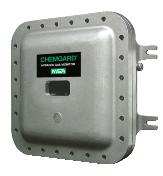
The Chemgard photoacoustic infrared (IR) gas monitor with IR sensing technology provides precise, low-cost, high-performance monitoring for one hundred different industrial gases. These gases include 59 standard gases, such as hydrocarbons, solvents, alcohols, CO2 and CO, to name a few.
The Chemgard gas monitor uses photoacoustic IR technology, which ensures extreme stability, operation for months with virtually no zero drift and makes it highly selective to the gas of interest. This technology takes a gas sample into the monitor’s measurement chamber and the sample is exposed to a specific wavelength of IR light. If the sample contains the gas of interest, that sample will absorb an amount of IR light proportional to the gas concentration that is present in the sample. Photoacoustic IR analysis, however, extends beyond simply measuring the amount of IR light that is absorbed; this technology actually detects what occurs after the gas is absorbed. Always in motion, gas molecules move around the inside of the measurement chamber, generating pressure. A highly sensitive microphone detects the audible pulse to even the lowest gas levels. There is no downtime, no fresh air sampling lines required and lower detection levels, down to 1ppm, for faster response.
Three different enclosure styles ensure there is a configuration for wildly different applications. The NEMA 4 version in a rugged metal enclosure is dust and water-resistant and provides four sturdy wall-mount tabs on the enclosure back for easy installation. The rack-mount version in standard 19in configuration provides handles on both sides of the front panel for easy cabinet extraction. The explosion-proof version is UL-listed and rated for Class I, Div. 1, Groups B, C and D areas, and comes with four wall-mount tabs on the back corners of the unit.
The Chemgard monitor features easy-to-read displays, three alarm levels, UL 2075 approval and data logging, granting users access to date stamped information on key events, including gas readings, alarms and fault conditions.

